Serviços Personalizados
Journal
Artigo
Indicadores
-
 Citado por SciELO
Citado por SciELO -
 Acessos
Acessos
Links relacionados
-
 Similares em
SciELO
Similares em
SciELO
Compartilhar
CIDADES, Comunidades e Territórios
versão On-line ISSN 2182-3030
CIDADES no.41 Lisboa dez. 2020
https://doi.org/10.15847/cct.20485
ORIGINAL ARTICLE
The morphological impact of municipal planning instruments on urban agriculture: The case of Lisbon’s Greater Area
Ana Mélice DiasI; Teresa Marat-MendesII
[I]CITTA, Faculdade de Engenharia, Universidade do Porto, Portugal. e-mail: amcmd@iscte-iul.pt.
[II]DINÂMIA’CET-Iscte, Portugal. e-mail: teresa.marat-mendes@iscte-iul.pt.
ABSTRACT
With the growth of urban population, humanity faces new challenges concerning urban food provision. Urban planning is paramount to guarantee a sustainable functioning of the several systems which operate within the urban realm, including the food system. However, while it is widely acknowledged that urban planning would benefit from the integration of urban agriculture, which operates at the production stage of the food system, it is less clear what are the morphological impacts of planning instruments on urban space, in terms of urban agriculture. This paper tries to address this gap, while focusing on one particular area of Portugal, Lisbon and its surrounding territory (Lisbon’s Greater Area). The proposed methodological approach aims to trace the perception of urban agriculture by municipal planning instruments (Municipal Master Plans) and identify their impact in contemporary urban agriculture solutions. It concludes that current planning regulations in Lisbon’s Greater Area are specifically focused on morphological solutions that give preference to urban agriculture uses related to leisure and aesthetic solutions, in determinant of design solutions that tackle economic growth or ecological diversity.
Keywords: Urban agriculture, Municipal Master Plan, urban and rural soil, urban morphology, Lisbon’s Greater Area.
1. Introduction
In a world where “sustainability” has become dominant in the discourse about cities, the question of how to feed the urban population demands further attention and consequent revision. In 2014, 54% of the total urban population was already accounted in urban areas, a number that is expected to grow by 1.63% between 2020 and 2025 (World Health Organization, 2020). This situation underlines the pertinence of food production on planet Earth. As primary consumers, cities must devise ecologically and socially responsible strategies to respond to their food demands. For that purpose, Urban Planning is strategic to account for the sustainability of the several systems that operate within the territory, including the food system, because it directly impacts on the productive spaces necessary to guarantee the food provision for the urban population.
The morphological impact of production spaces in the urban territory demands further recognition in order to better support future urban planning decisions. However, unlike the health, social and ecological concerns (Cabannes and Raposo, 2013; Giles-Corti et al., 2016; Jiao, Vernez Moudon and Drewnowski, 2016; Vernez Moudon et al., 2013; Wekerle and Classens, 2015), the morphological concerns that condition such productive spaces are scarcely mentioned in the overall urban planning literature (Mélice Dias, 2018).
The aim of this article is to fill this gap by examining how urban agriculture is perceived in planning instruments and what morphological specifications, if any, or objectives these might indicate. As the primary indicators for planning practices, these instruments hold the potential for introducing sustainable changes in the urban food system. Thus, studying their organization and guidelines is of vital importance to understand how to apply the aforementioned changes. This article does this by proposing a specific multiple approach methodology that analyses how current planning instruments guidelines include and/or exclude urban agriculture, or even general agriculture.
This paper focusses on one specific planning instrument, responsible for the municipal structuring of the entire Portuguese territory, the Plano Diretor Municipal (Municipal Master Plan), or PDM. In doing so, it assures that all analysed municipalities are compared with the same standard, in terms of territorial scale and land management.
For the purposes of this study, only a specific Portuguese region will be discussed, Lisbon’s Greater Area, a diverse territory comprised of nine municipalities (Amadora, Cascais, Lisboa, Loures, Mafra, Odivelas, Oeiras, Sintra and Vila Franca de Xira) (See Figure 1).
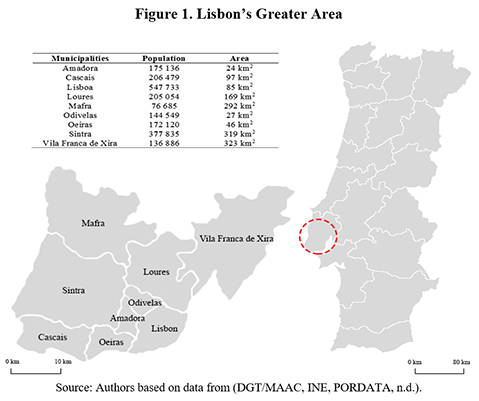
The following analysis demands the clarification of key concepts, “urban”, “urban agriculture” and “urban morphology”. Given the focus of this article on the specificities of the PDM, it sought to base these concepts on existing information from these planning instruments. However, this was not always possible, and other specific documents identified in our literature review supported our conceptualization, according to the most relevant principles of our study.
In the case of “urban” and the intrinsic problematic of where to set its borders, its conceptualization is hindered by the many nuances between urban and rural provided by the ever-growing periphery (Domingues, 2019). This article will not detail these issues; instead, it focusses on the definition provided by the planning instruments under study and what implications it might have for urban agriculture and its spatialization. The definition of “urban soil” provided by the PDMs will be exemplified using the case of the PDM of Cascais, which states “(…) the one to which is recognized the propensity for the process of urbanization and building, comprising the urbanized terrains or whose urbanization is possible to programme and the terrains related to the urban ecology structure, constituting the entirety of its urban perimeter.”[3](Câmara Municipal de Cascais, 2015, pp. 17450-(5)-17450-(63)). Though it recognizes that ecological spaces can and should exist inside the urban perimeter, the primary focus of “urban soil”, according to the PDMs, is to build. This corresponds to a general tendency to prioritize built activities over unbuilt ones, such as agriculture (Parham, 2015b), resulting in a general disregard for it as an urban activity and for its spatiality as an issue to contemplate in urban planning. These questions will be addressed in more detail in the next sections of this article.
“Urban agriculture”, on the other hand, lacks a conceptual point-of-view from the analysed PDM. Hence, this article adopted the definition provided by the Research Centre for Urban Agriculture and Food Security (RUAF) in 2006, as it provides a comprehensive perspective that considers all the possible needs of city-dwellers and the multiple opportunities for agriculture that a city can provide. As cited by Delgado (2018: 170), urban agriculture is considered: “(…) the growing of plants and the raising of animals within and around cities. The most striking feature of urban agriculture, which distinguishes it from rural agriculture, is that it is integrated into the urban economic and ecological system: urban agriculture is embedded in – and interacting with – the urban ecosystem. Such linkages include the use of urban residents as labourers, the use of typical urban resources (like organic waste as compost and urban wastewater for irrigation), direct links with urban consumers, direct impacts on urban ecology (positive and negative), being part of the urban food system, competing for land with other urban functions, being influenced by urban policies and plans, etc. (…)”. This article will adopt this concept of urban agriculture as a way to better understand which of these dimensions of urban agriculture, if any, is captured in the PDMs.
Finally, regarding the concept of “urban morphology”, although it is mentioned in some PDMs, its meaning is never fully detailed, though its consideration in planning processes is recognized as beneficial to increase knowledge on urban structures and transformations (Oliveira, 2011). Therefore, this article follows Oliveira’s definition (2016: 2), as the “(…) study of urban forms, and of the agents and processes responsible for their transformation (…)”. Oliveira identifies cities as the main object of study, rather than a single activity occurring in cities, of which urban agriculture is an example. However, Oliveira’s concept considers the implications of external processes and entities shaping the final result, which directly reflects on the purposes of this study. In this case, instead of focusing on urban tissues, streets (and squares), urban plots and buildings as the main structuring elements of urban morphology, this article focuses on the location of the activities that do occur in these spaces, specifically urban agriculture, the materials and technologies used in these activities and the plot dimensions it allows.
Our analysis was conducted in the scope of Project SPLACH – Spatial Planning for Change, a research project funded by the Portuguese Foundation of Science and Technology (Fundação para a Ciência e a Tecnologia), which aims to contribute to the delineation of a compendium of urban policies to benefit a sustainable urban transition of the current food system that operates within the Lisbon Metropolitan Area.
SPLACH is an all-encompassing project, approaching multiple topics of planning research, including urban metabolism, food security, sustainable tourism, governance, transformative public policies and urban modelling, covering a total of 10 working packages. This article focusses on work which aimed to contribute to Working Package 3 – ‘Food security and Sustainability’, specifically in terms of the production stage. It is sustained on information gathered from a specific pilot case study and on the methodology used to investigate issues related to the food system. The pilot case was conducted in Lisbon’s Greater Area and intended to unveil: i) how urban agriculture is perceived within municipal planning instruments; and ii) what shapes of urban agriculture occur in this territory at present. Its main results are systematized in the work The Shape of Food: An Analysis of Urban Agricultural Shapes in Lisbon’s Greater Area (Mélice Dias, 2018).
This article is structured around five sections. After giving a contextualization of the problematic under analysis, it offers a brief review of the most relevant literature on the relationship between urban planning and urban agriculture and the current case of affairs in certain cities in Portugal. The ensuing section details the adopted methodology to investigate how urban agriculture is perceived in the PDMs and the different levels of analysis it entails, followed by its main findings. Finally, some last remarks are then provided to support the main findings.
2. Literature review
The beginning of the new millennium witnessed a greater integration of food concerns in the mainstream political discourse (Morgan, 2014). Yet, its transposition from theory into practice still faces certain difficulties, particularly when addressing agriculture and its integration into the urban fabric.
A major factor for this disconnection seems to stem from the current dominant urban/rural dichotomy which denotes a contemporary cultural issue that somehow restricts the expansion of the agricultural concept beyond rural boundaries. Through their interviews with planning officials, Pothukuchi and Kaufman (2000) reveal how this restriction excludes urban planning entities from considering the introduction of agriculture in cities in any engaging way. Furthermore, Mubvami and Mushamba (2006) reiterate how omitting agriculture from urban land-use leads to its exclusion from integrated urban strategies.
As a result, urban agriculture initiatives tend to be simplified versions of the agricultural activity and are scantly integrated into urban planning. According to Viljoen and Bohn (2014), such integration depends on four factors: (i) research and planning-led urban design and architectural concepts to cohesively integrate urban agriculture in the urban fabric; (ii) clear applicable guidance and dissemination of best practices to foster urban agriculture projects; (iii) assuring urban agriculture practices and sites by creating recognizable regulations or agreements with planning and other food related entities; and (iv) integrating urban agriculture in mainstream production and procurement systems.
Regarding the first factor, the design and analysis of urban agriculture projects appears to be hindered by this general application of simplified versions of agriculture. The work of Vitiello and Brinkley (2014) clarifies this by exposing how agriculture has become detached from American urban planning. If agriculture is mostly being reneged to areas outside of the urban perimeter, then existing urban agriculture sites do not hold enough manifestation in the urban fabric to require a systematic analysis of its spatiality and inherent impact in the urban system. As a result, current urban agriculture projects are being demoted by American governmental and planning entities to a means of beautifying rundown neighbourhoods (Vitiello and Brinkley, 2014). This simplification of agriculture is also present in the Portuguese context, specifically in the case of Lisbon’s Greater Area (Dias, 2018; Mélice Dias, 2018).
Similarly, disseminating applicable guidelines and best practices, the second factor identified by Viljoen and Bohn’s, is restricted by the amount and diversity of urban agricultural cases. Such is the case of the Urban Allotment Gardens project from the European research program COST (2012). This is a project which shares experiences of existing allotment gardens between various European cities and allows its dissemination to the general public through fact sheets. Here, as throughout this article, allotment gardens refer to urban spaces, divided into small plots dedicated to the growing of vegetables and fruits by the surrounding community. Notwithstanding the value of sharing clear information, reducing it to visually unimposing programmes, like allotment gardens, reduces the impact of the aforementioned dissemination efforts.
To avoid this problem, it is essential to understand when this tendency to diminish urban agriculture emerged. According to Vitiello and Brinkley (2014) this issue was identified as a problem by the twentieth-century planners, when confronted with the integration of agriculture within cities. According to them, this event contributed to expanding the number of unattractive constructions by the lower classes, while threatening overall urban aesthetics.
Today, similar concerns, such as fear for vandalism or abandonment, still obscure the necessary support to advance certain urban agriculture sites from project to actual implementation, especially when low-income populations are concerned. That is the case in Cascais, in Portugal, where the mayor had to overcome these concerns when he proposed the creation of the Adroana Allotment Garden (Câmara Municipal de Cascais, 2016a).
Parallelly, sprawling peripheries have distorted the notion of boundaries and placed greater pressure on agricultural spaces in these areas. Throughout the food chain, food spaces on the urban periphery have been competing with other development interests, thus becoming increasingly sparer and more fragmented. Overcoming this would require a food-centred planning perspective, with measures that consider agriculture with counter-sprawling measures such as land-use and transport planning and economic and fiscal instruments (Parham, 2015b).
Hence, change depends on real political and social commitment. In that regard, and focusing on Viljoen and Bohn’s third factor, there are currently several initiatives that appear to contribute in this direction, such as the Milan Urban Food Policy Pact (Milan Urban Food Policy Pact, 2014), which is an international protocol aimed at tackling food-related issues at the urban level, to be adopted by as many world cities as possible. Launched at the municipal level, it currently comprises more than 200 cities and integrates also several governmental departments and international organizations such as the United Nations (UN), the Food and Agriculture Organization (FAO), the European Commission (EC), among others.
The ambitious endeavour of creating sustainable urban food systems needs to engage different perspectives. The top-down point of view may have more power to change regulations and create big fund projects, but the bottom-up initiatives have a better sense of what the real needs of local populations are. As noted by Cabannes and Raposo (2013), on their analysis of peri-urban agriculture in Lisbon and London, this sort of agricultural activity is essential to guarantee social inclusion of migrant populations. At the same time, it expresses how relevant this community input is by providing their own knowledge to greatly assist on the creation of biologically diverse urban ecosystems.
Thus, sustainable changes in cities are also gained through the involvement of communities’ initiatives. In the case of the Associação para a Valorização Ambiental da Alta de Lisboa, or AVAAL (Alta de Lisboa Association for Environmental Appreciation), their tireless efforts have contributed to convince Lisbon’s municipality authorities to create a neighbourhood allotment garden (Cancela, 2014) (See Figure 2). This site, created in 2015, is organized according to different levels and plot dimensions. Higher plots are available to provide access to people who require the use of wheelchairs or have other specific mobility needs; while lower plots, of different sizes, provide more or less available space for agriculture, according to the need of food subsistence or the use agriculture as a leisure activity, respectively.
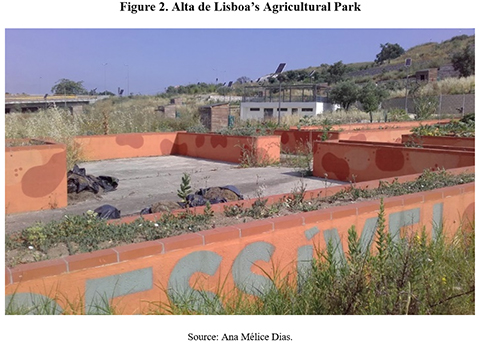
Urban agriculture organized as a bottom-up initiative can also emerge through a guerrilla approach, such as the one adopted by the community group ‘Incredible Edible’, in Todmorden, U.K. Their strategy is focused on the development of urban agriculture on abandoned lots and flower beds, which they identify and re-appropriate. The initiative gained support from the public and, eventually, from the municipality (Incredible Edible Network, n.d.; Dion et al., 2015; Reynolds, 2008).
The examples above identified highlight an emerging tendency in urban agriculture. Currently, allotment gardens are used as a representative of urban agriculture in general, suggesting that the concept is becoming solely focused on social and leisure benefits, while excluding economic considerations.
However, there is a great variety of agriculture programmes that can be introduced in cities. Napawan (2016) identifies several possibilities in San Francisco, California. They were suggested by the American Planning Association and the San Francisco Urban Agriculture Alliance (See Table 1).
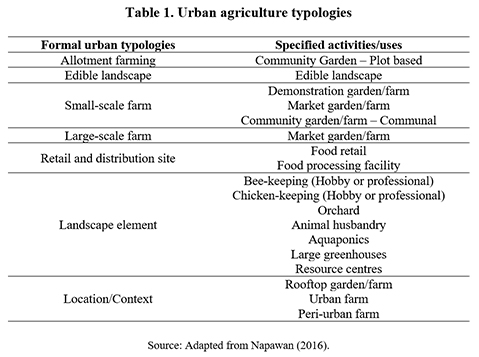
In the Portuguese case, Mélice Dias and Marat-Mendes (2018) reveal most of these options are overlooked in Lisbon and Cascais, two cities of Lisbon’s Greater Area, in favour of unimposing allotment gardens. Larger sites and projects are being placed either in private land or in urban soil, away from the urban social and commercial connections. Figure 3, Table 2 and Table 3 list identified sites, their location, activities or uses conducted in the site.
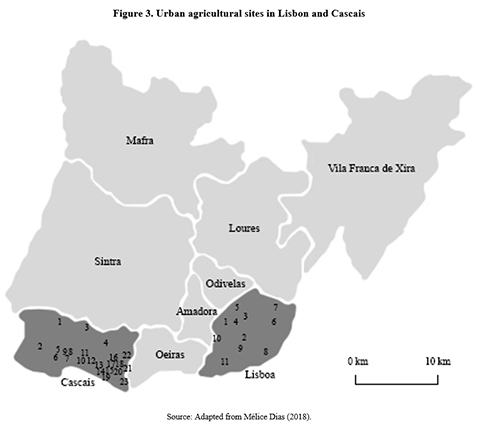
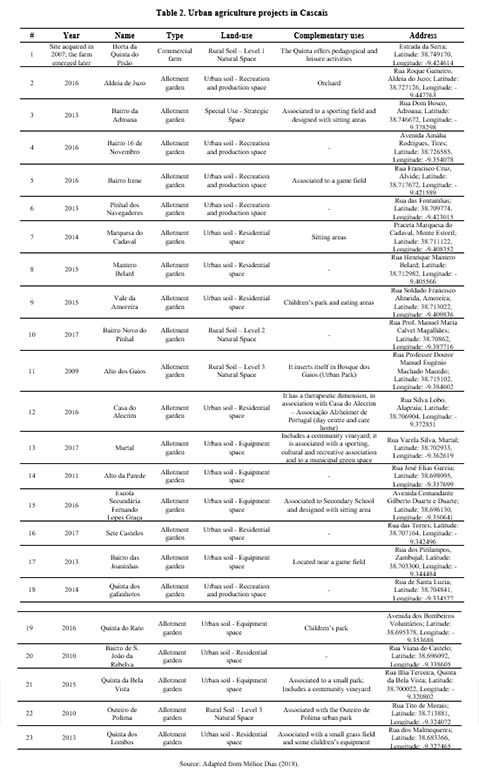
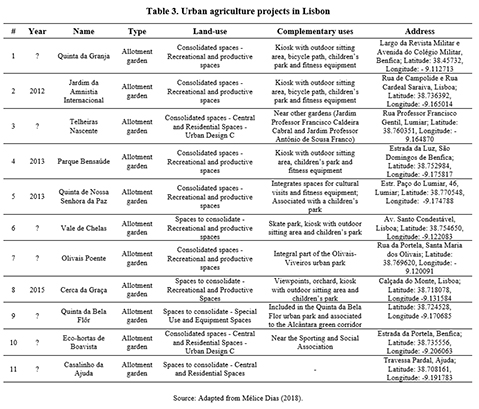
In Lisbon, for example, a large public park, the Quinta da Granja, was only fitted with two sets of allotment gardens, occupying a mere fraction of its space (See Figure 4). Conversely, in Cascais a large commercial farm was placed in the outskirts of the city, the Quinta do Pisão (See Figure 5).
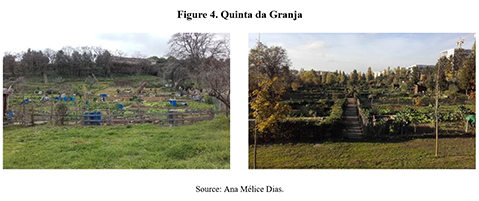
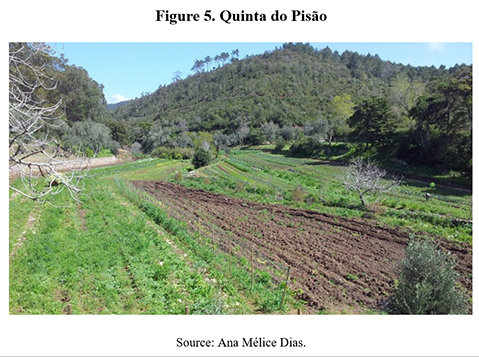
Cascais created other large-scale projects to encourage agriculture as a business within the municipality, yet they either function on private land, thus hindering their visibility as a public space, or the projects are still in early stages of development and, consequentially, no location has been announced.
The Hortas Ninho project, for example, is mentioned in the website of Cascais municipality (Câmara Municipal de Cascais, 2019) and in its Activities and Budget Plan of 2016 (Câmara Municipal de Cascais, 2016b). It is indicated as a space for people interested in initiating their agriculture business. Furthermore, there is also the Horta do Brejo project, which is explored by inmates from the local Tires female prison to supply and finance the prison and the local Food Bank.
In both cases, no more information is provided, but the strategy followed by Cascais suggests that the Hortas Ninho project will probably be located in the rural outskirts of the municipality, as the case of Quinta do Pisão.
Another example, the Banco de Terras project, reveals how Cascais promoted connections between landowners and people interested in agricultural activity, either for leisure or business motives. This project is currently in action but, due to its nature, it is only active in private land (Câmara Municipal de Cascais, 2019).
As indicated by Viljoen and Bohn in their fourth factor (2014), urban agriculture needs to be implemented in the current urban food networks, which entails a connection to other urban systems, including the economic system.
This need to create connections is also described by Cohen (2014) who identifies the support of emerging forms, scales and configurations of urban agriculture as essential to support a stronger food system framework that goes beyond conventional zoning. Similarly, the London Assembly Planning and Housing Committee (2010) has suggested, among other recommendations, the inclusion of urban agriculture in waste, water, energy and food municipal strategies. Lastly, White and Natelson, as cited by Morgan (2014), suggest that the urban foodscape could be reformed through the relationship between producers and urban consumers, by creating jobs and financially supporting urban food circuits.
As noted, several steps have been taken to provide the inclusion of the food system within urban planning. However, based on the examples provided so far, we argue that urban agriculture is still associated with preconceived notions that date back to a culture that rests on urban/rural divide and, consequentially, lacks political commitment and involvement in urban planning.
To understand how to close this gap between knowledge and actual implementation, it is necessary to know what measures are being put into place and how these can be improved. Hence the need to conduct a comprehensive analysis of the existing municipal planning instruments and of the guidelines that they provide. The following sections will reveal how these concepts relate to the Portuguese context, specifically within Lisbon’s Greater Area.
3. Municipal Master Plans and their connection to urban agriculture
To understand the emphasis of planning on urban agriculture this study hinges on the analysis of one specific and comprehensive planning instrument, the PDM (Plano Diretor Municipal), or the Municipal Master Plan. From the various planning instruments structuring the Portuguese territory, the PDM offers the best conditions to conduct a systematic analysis of different territories for indicating what future decisions and aims should be implemented.
In terms of scale, it balances detailed projects and comprehensive strategies, namely those at national and regional level. It simultaneously comprises guidelines on how to guarantee the overall strategy and what specific design features are allowed, thus considering a more complete point-of-view than other existing Portuguese guidelines. It also pertains to both urban and rural soil, a feature not transversal across planning instruments (Lopes, 1990).
In terms of scope, unlike the national and regional guidelines, which only concern public entities, the PDM’s authority submits both public and private agents to its regulations, thus assuring a relatively homogenous compliance with assumed guidelines (Lopes, 1990).
As previously mentioned, the analysis is based on a clearly delimited and diverse territory, the Lisbon’s Greater Area. This is a territory which has featured the growth of urban agriculture. This phenomenon has occurred in fully urbanized municipalities, such as Lisbon, but also in municipalities with urban and rural land uses. This varied range of classifications offers multiple opportunities for urban agriculture and variations in planning approaches without demanding an analysis at a larger regional scale.
This section introduces the PDMs of these municipalities and the methodology applied in their analysis. Finally, it overviews what emphasis is provided by Lisbon’s Greater Area PDMs on urban agriculture, while focusing on three specific topics: i) the rural/urban opposition; ii) the urban agriculture design specifications; and iii) the evolution of the agricultural activity.
3.1. The PDM – Municipal Master Plan
The Municipal Master Plan (Plano Diretor Municipal - PDM) was established as the first Portuguese planning instrument to cover the entire municipal territory (Ministério da Qualidade de Vida da Administração Interna e da Habitação Obras Públicas e Transportes, 1982). It was created with the aim to supply a programmatic framework; defining guidelines to and from reginal and national scales; and providing opportunity for public participation and strategy definition. On a more practical level, it also aimed to define land-use, the urban network, administrative boundaries, the public transport network and to assure the proper utilization of natural and cultural resources (Ministérios da Qualidade de Vida da Administração Interna e da Habitação Obras Públicas e Transportes, 1982).
Nevertheless, the PDM is subordinate to the national and regional plans and to the legal schemes of territorial planning, namely the Legal Regime of Spatial Planning Instruments ( Regime Jurídico de Instrumentos de Gestão Territorial), or RJIGT, originally created in 1999 (Ministério do Equipamento do Planeamento e da Administração do Território, 1999) and the Ground Basis Law on Spatial and Urban Planning (Lei de Bases de Políticas de Ordenamento do Território e de Urbanismo), or LBPOTU, created in 1998 (Assembleia da República, 1998). These two instruments (RJIGT and LBPOTU) were updated in 2015 (Ministério do Ambiente Ordenamento do Território e Energia, 2015) and 2014 (Assembleia da República, 2014)[4], respectively.
The latter determines the hierarchical organization of the PDM. Specifically, it establishes that land-use classes determine the basic destination of soil. This refers to an ‘urban’, ‘rural’ or ‘special’ class, while the activities and constructions permitted within each class are determined by land-use categories. These distinctions will be analysed in the following section, in Table 5 and Table 6. Urban land corresponds to space either built or to be built, while rural land is the remaining space. The introduction of such a hierarchical organization generated substantial changes in the way agriculture was perceived and accepted in the Portuguese territory.
Therefore, our analysis took into consideration the historical evolution of the PDM instrument, which has already experienced two generations, separated by the introduction of the LBPOTU. The first generation corresponds to when the PDMs were created, between 1993 and 1999, an era preceded by an economic and political crisis and the consequent entry into the European Economic Community (now, European Union). The following generation, took place between 2009 and 2015, an era also marked by the emergence of an economic crisis, in its later years experiencing the beginning of an economic recovery.
Currently, there is a third generation of PDMs being developed, namely regarding Sintra, where the new revision of the PDM was announced in 2020 (Presidência do Conselho de Ministros, 2020). However, this study seeks to focus on PDMs with longer periods of implementation to allow an analysis of the changes and permanence which have occurred in their respective territories. Thus, our study only considered the two first generations of PDMs for the nine municipalities under observation (See Table 4).
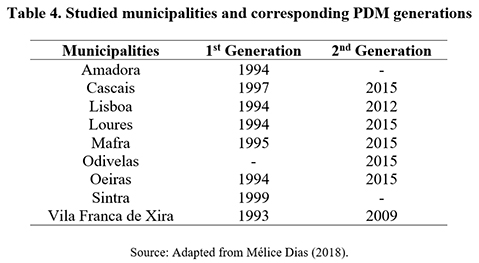
Only the original PDMs and their integral revisions that substituted them in their entirety were considered in this study, hence excluding partial revisions such as those introduced by Amadora and Sintra. Not all municipalities implemented their PDM’s in the same period of time, nor have they fulfilled the legal requirement of a ten-year period to complete their PDMs revision. Furthermore, Odivelas was only established as a municipality in 1998, after its detachment from Loures.
3.2. Data collection and research method
Even though a single planning instrument is being analysed, the PDM structure differs drastically between municipalities and throughout the years. Despite hindering the search for information related with urban agriculture, these changes revealed how each municipality addressed urban planning in general, offering insights into the role of urban agriculture in the overall municipal structure.
This section details the adopted research method, which required a specific lens of analysis, to simultaneously track the changes in the PDMs structure and circumvent them to focus on the information pertaining to urban agriculture. To do so, the entirety of the documents was analysed to identify where in the PDM document urban agriculture is featured or where there was a possibility for it to be featured. The latter refers specifically to the themes of agriculture, urban green spaces and sustainability and it might offer a subjective view-point, as it was based on a notion of green spaces and sustainability that includes the topic of urban agriculture. The information retrieved from our analysis, including the identified features, or possible features, were then organized according to three tools of data recording: visual charts, extensive tables and resumed tables.
The visual charts record the evolution of the agriculture concepts within the PDMs throughout the years. This method exposes the hierarchic levels of each PDM and the different terms or words used within these documents to define agriculture, as well as its frequency throughout the document. Furthermore, references to sustainability and design constraints associated to agricultural spaces were also identified and highlighted. This instrument was particularly helpful to understand how each municipality changed its territorial structure throughout the years and how urban agriculture evolved along with the remaining land-uses.
The extensive tables of data, from all the PDMs, were organized regardless of their year. These tables were fundamental to understand what determinations were being made regarding urban agriculture. They focused on six questions: i) How did the organization of the PDM document evolve from the first generation to the last one? ii) Is the theme of urban agriculture included or excluded in the PDM primary issues? iii) Does the PDM integrate urban agriculture in the Portuguese planning instruments that identify the territories with the greatest potential for agriculture (National Agricultural Reserve[5]) and ecologic preservation (National Ecological Reserve[6])? iv) What are the guidelines for green spaces and is agricultural production considered compatible with them? v) Are agricultural spaces defined as rural, urban, both or a special subject? vi) What are the spatial constraints imposed over the agricultural spaces?
Finally, the resumed tables focused on specific keywords. By simplifying the data to its most basic information, these tables clarified the perception of urban agriculture throughout the years and across municipalities. The first table focused on land use class or classes which allow agriculture to occur, urban, rural, both or a special class. The latter refers particularly to the first generation of PDMs, where agriculture was often classified as a class on its own, and not subordinated to urban or rural. The name by which this special class was referred to varied between municipalities and years. To clarify its understanding, the table simply refers to it as ‘Special’ (*) (See Table 6). The second table concentrated on types of constructions and activities allowed in agricultural spaces in general, namely the categories within the aforementioned classes (See Table 5).
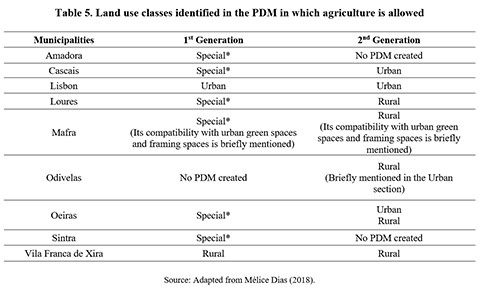
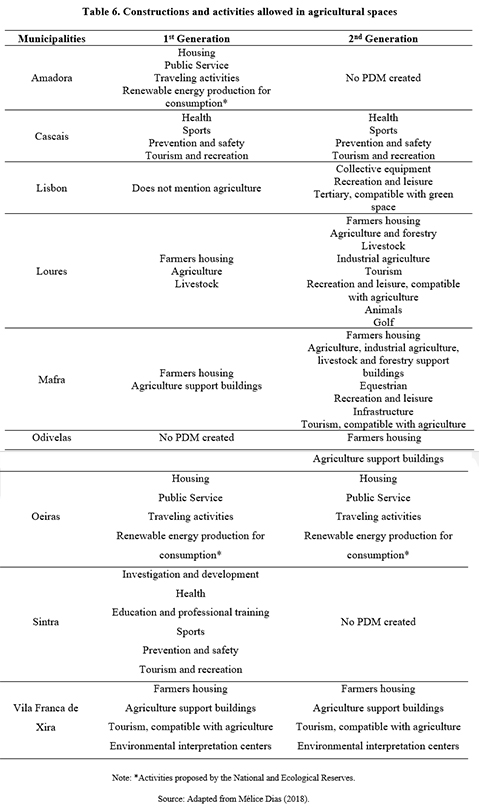
4. The place of urban agriculture in municipal planning instruments
4.1. The rural/urban opposition
Our analysis revealed that the introduction of the LBPOTU in 1998 initiated a simplification in the land use classification. Before LBPOTU, land was divided according to urban, rural and a wide range of other uses, e.g. culture. At that moment, agriculture was considered independent from either rural or urban class. After 1998 the land classes became divided between urban and rural, while the other classes were adopted as categories, subordinated to either urban or rural classes. Throughout this process, agriculture became associated to rural land in most of the analyses PDMs, losing its former transversal status (See Table 3). Vila Franca de Xira emerges as an exception, as it always considered agriculture a category subordinated to the rural class (Câmara Municipal de Vila Franca de Xira, 1993).
However, certain municipalities appear to have contributed to the conceptualization of agriculture as a transversal activity. Such is the case of Cascais and Oeiras, which allow the presence of agriculture in both urban and rural areas, while Lisbon, despite not having rural land, does allow agriculture in its urban green land. Odivelas also enables food production in urban green spaces (Câmara Municipal de Cascais 2015; Câmara Municipal de Oeiras 2015; Câmara Municipal de Lisboa 2012; Câmara Municipal de Odivelas 2015).
These exact municipalities expressed in their PDMs social and self-sufficiency concerns as the main drivers for the acceptance of urban agriculture. Specifically, to contribute to promoting levels of self-sufficiency of the municipality; aiding cohesion to urban communities; promoting urban resilience and environmental, social and cultural quality to the urban fabric (Câmara Municipal de Cascais 2015; Câmara Municipal de Oeiras 2015; Câmara Municipal de Lisboa 2012; Câmara Municipal de Odivelas 2015).
Remarkably, these correspond to the most densely populated municipalities of Lisbon’s Greater Area, with the exception of Amadora, that ranks higher (DGT/MAAC et al., n.d.). This suggests demographic pressure might be one of the reasons why urban agriculture is being promoted as one possible solution to ease social, ecological and food scarcity issues.
This highlights the importance of assuring agricultural land in urban soil. Portugal does have an instrument dedicated to protect land with the greatest potential for agriculture, the National Agriculture Reserve (Reserva Agrícola Nacional), yet it does not extend into the urban territory (Ministério da Agricultura do Desenvolvimento Rural e das Pescas, 2009). Given its flexibility between territorial scales and its coverage of both private and public land, the PDM provides a great opportunity for addressing that gap.
The divide between urban and rural is a very pressing reality in twenty-first century Lisbon Greater Area. Considering the increasingly thinner barriers between urban and rural (Domingues, 2019), and the continuous population growth in already dense areas (Marques, 2002), the normative association of agriculture exclusively to rural land should be questioned.
4.2. Design specifications
Spatial constraints related to urban agriculture were effectively retrieved from our PDM analysis. This is a term, used by the PDMs, to refer to a set of guidelines that define specific design features that must be considered. In the case of urban agriculture, our PDM’s evolutive analysis has allowed us to conclude that these guidelines have been decreasing in content throughout the years, hindering the use of urban agriculture as an activity that could contribute to the sustainability of the urban environment.
The PDMs of Cascais, Lisbon, Oeiras and Odivelas are the only ones from Lisbon’s Greater Area which have considered spatial constraints for urban agriculture. Yet, they only define the constructions and activities which are allowed to occur in association with agriculture (See Table 2) (Câmara Municipal de Cascais, 2015; Câmara Municipal de Oeiras, 2015), types of flooring, bureaucratic measures (Câmara Municipal de Lisboa, 2012) and types of plants permitted (Câmara Municipal de Odivelas, 2015).
Nevertheless, the reduced number of guidelines grants some freedom in the design of agricultural spaces. For example, it can allow an allotment garden to specify different plot sizes, according to the specific needs of its local population; and therefore, prioritizing social connections or production of food for sustenance according to the specific socioeconomic context, such as in the case of AVAAL (See Figure 2) (Cancela, 2014). Such considerations can have powerful ramifications in fostering a sense of community and social integration as already claimed (Cabannes and Raposo, 2013; Parham, 2015a).
However, it also allows urban agriculture to be used as a response to market trends, such as recreation and tourism. This can be observed in the case of Lisbon and Cascais. Information gathered from previous morphological analyses of urban agriculture experiences identified in Lisbon’s Greater Area (Mélice Dias et al., 2018), and from the websites of the municipalities of Lisbon and Cascais (Câmara Municipal de Cascais, 2019; Câmara Municipal de Lisboa, 2018) shows a clear trend towards allotment gardens, with thirty-three of thirty-four cases (twenty-two from Cascais and eleven from Lisbon) following the same pattern.
Indicating that morphologic specifications are required on the local or project scale could clarify any uncertainties related to overall urban agriculture strategies as well as their morphology (Mubvami & Mushamba, 2006), avoiding the risk of creating spaces defined by market trends instead of the actual needs of the territory, population and urban ecology.
4.3. Evolution of the agricultural activity
Table 2 and Table 3 reveal how PDMs have come to perceive agriculture in the context of leisure and recreation. Throughout the years the number of municipalities in Lisbon’s Greater Area allowing tourism and/or leisure activities in agricultural land have increased in the PDMs which mention agriculture from three out of seven (42,9%), to six out of nine (66,7%).
The agricultural projects, proposed in the PDMs, support this leisure tendency, namely the Parque Agrário da Várzea e da Costeiras de Loures (Varzea and Costeiras de Loures Agrarian Park), which holds as its primary objective the “Acquisition of a multifunctional space that matches the functions of agricultural production with nature preservation, environmental regulation and recreation and leisure for the population[7]” (Câmara Municipal de Loures, 2015: 16366). Similarly, the project for Quinta da Paiã (Paiã Farm) proposes a municipal park connected to the agricultural and educational areas. The goal is to validate the “(…) areas integrated in RAN through the implementation of agricultural activities as urban food gardens, educational farms, interpretative centres, among other agriculture related initiatives.[8]” (Câmara Municipal de Odivelas, 2015: 25487). Additionally, Lisbon’s PDM proposes transversal uses for urban agriculture and horticulture for the northern edge and for the western and eastern areas but does not further develops their scope (Câmara Municipal de Lisboa, 2012).
However, two of the densest Lisbon’s Greater Area municipalities, Lisbon and Cascais, in addition to Sintra, prohibit buildings for agricultural, agro-industrial, livestock and forestry activities in their PDMs. Typically, these uses are integrated into rural land and are authorized by the National Agricultural Reserve. Their exclusion further indicates a need to distance rural and urban, even when addressing common activities. More drastically, it hinders the use of urban agriculture as an economic activity, reducing its range to small scale enterprises and reducing its impact in the urban planning.
5. Final remarks
Urban agriculture provides the chance to introduce sustainable practices in urban settings. For that to occur, urban planning needs to consider its capabilities and foster its advantages. This study has approached stereotypes attributed to the roles of urban and rural and analysed how these may have contributed to accentuating the divide between them and hindered the possibility to process agriculture in an urban context.
To change this situation, planning instruments should recognize agriculture as a transversal activity, capable of being adapted to rural and also urban settings, but also of producing morphological impacts on the ground. Furthermore, as suggested by Mubvami and Mushamba (2006), acknowledging the social, biological and economic advantages of urban agriculture as a contributory requisite to integrate the urban agriculture activity in the urban system is essential.
However, as this study has confirmed, the presence of such paradigms was not verified in Lisbon’s Greater Area, where the PDMs indicate timid approaches to the topic and are unclear in specifying political, economic or spatial measures to promote it. This study concludes that there are no planning guidelines in place that can overcome previous results regarding the homogeneity of spatial solutions in the municipalities of Lisbon’s Greater Area. The urban space is composed of more than leisure and tourism. Urban agriculture should reflect this variety of spatial solutions, as it happens for other urban activities, so it can better respond to the economic and ecological needs of cities.
Analysing the contents of planning instruments in Lisbon’s Greater Area through a comprehensive point of view towards agriculture has suggested a series of issues which might be tested in other cities. The applicability of this approach in further studies transposed into other cities is welcome, to check whether the identified results are replicable elsewhere through similar methods of analysis, and therefore promoting a more comprehensive understanding of planning gaps in urban agriculture. Such studies could apply this base knowledge to further this investigation aided also by other planning instruments, as well as surveys or interviews to planning entities and actors related to urban planning.
The subject of planned urban agriculture is relatively recent in Lisbon’s Greater Area, thus its long-term results cannot be analysed yet. Furthermore, our examination has focused on a relatively small area of one single country. In the future, it will be important to improve our current understanding of the morphological impact of urban agriculture by applying this methodology to other geographical contexts, with distinct morphologies and socioeconomic settings. Broadening the previous survey of existing agricultural spaces might provide the means to further compare the proposed methodology and ensuing results with their actual materialization in the urban space.
Project SPLACH has made use of this pilot case and adapted its methodology to the survey of existing urban agriculture cases within the overall area of Lisbon’s Metropolitan Area, which includes eight other municipalities in more rural settings. It would be interesting to extend the same questions to not only the rest of Portugal but also other countries, in order to identify more planning strategies regarding urban agriculture and to determine which measures can be applied in other settings, and which ones can be accounted as universal ones.
Funding
Grant POCI-01-0145-FEDER-016431, by the European Structural and Investment Funds (ESIF) through the Operational Thematic Program for Competitiveness and Internationalization (COMPETE 2020) in its European Regional Development Fund and by National Funds through the Foundation for Science and Technology Portugal (FCT).
References
Assembleia da República (1998) Lei n.o 48/98. Diário da República, I-A, 148 (August), 3869-3875. Retrieved from https://data.dre.pt/eli/lei/48/1998/08/11/p/dre/pt/html [ Links ]
Assembleia da República (2014) Lei n.o 31/2014. Diário da República, I, 104 (May), 2988-3003. Retrieved from https://data.dre.pt/eli/lei/31/2014/05/30/p/dre/pt/html [ Links ]
Cabannes, Y., Raposo, I. (2013) “Peri-urban agriculture, social inclusion of migrant population and Right to the City: Practices in Lisbon and London”, City, 17(2), 235-250. https://doi.org/10.1080/13604813.2013.765652
Câmara Municipal de Cascais (2015) Revisão do Plano Director Municipal de Cascais - Aviso n.o 7212-B/2015. Diário da República, II, 124 (June), 17450-(5)-17450-(63). Retrieved from https://dre.pt/web/guest/pesquisa/-/search/67641490/details/normal?q=Aviso+n.o 7212-B%2F2015 [ Links ]
Câmara Municipal de Cascais (2016a) Inauguração da Horta Associativa da Adroana. Retrieved from https://www.youtube.com/watch?v=z23rTACbw3M [ Links ]
Câmara Municipal de Cascais (2016b) Plano de atividades e orçamento 2016. Cascais. Retrieved from https://www.cascais.pt/sites/default/files/anexos/gerais/new/cascais_ambiente_plano_atividades_e_orcamento_2016.pdf [ Links ]
Câmara Municipal de Cascais (2019) Cascais Ambiente. Retrieved January 11, 2019, from http://www.cascaisambiente.pt/pt [ Links ]
Câmara Municipal de Lisboa (2012) Revisão do Plano Director Municipal de Lisboa - Aviso n.o 11622/2012. Diário da República, II, 168 (August), 30275-30377. Retrieved from https://www.lisboa.pt/fileadmin/download_center/notificacoes/avisos/PDM_DR_2s_n168_Aviso_n11622_2012.pdf [ Links ]
Câmara Municipal de Loures (2015) Revisão do Plano Director Municipal de Loures - Aviso N.o 6808/2015. Diário da República, II, 117 (June), 16339-16391. Retrieved from https://dre.pt/web/guest/pesquisa/-/search/67524017/details/normal?q=Aviso+N.o 6808%2F2015 [ Links ]
Câmara Municipal de Odivelas (2015) Plano Director Municipal de Vila Odivelas - Aviso 10014/2015. Diário da República, II, 171 (September), 25446-25500. Retrieved from https://dre.pt/web/guest/pesquisa/-/search/70170154/details/normal?q=Aviso+10014%2F2015 [ Links ]
Câmara Municipal de Oeiras (2015) Revisão do Plano Director Municipal de Oeiras - Aviso n.o 10445/2015. Diário da República, II, 179 (September), 26462-26480. Retrieved from https://dre.pt/web/guest/pesquisa/-/search/70280688/details/normal?q=Aviso+n.o 10445%2F2015 [ Links ]
Câmara Municipal de Vila Franca de Xira (1993) Regulamento do Plano Director Municipal de Vila Franca de Xira. Diário da República, (64), 1260-1271. [ Links ]
Câmara Municipal de Vila Franca de Xira (2009) Revisão do Plano Director Municipal de Vila Franca de Xira - Aviso n.o 20905/2009. Diário da República, II, 224 (November), 46954–46995. Retrieved from https://dre.pt/web/guest/pesquisa/-/search/1951376/details/normal?q=Aviso+n.o 20905%2F2009
Cancela, J. (2014) A Agricultura urbana na operacionalização da estrutura ecológica municipal. O estudo de caso do Parque Agrícola da Alta de Lisboa. FAUL-IUL, Lisboa. Retrieved from https://www.repository.utl.pt/bitstream/10400.5/7183/1/Tese_dout_jorge_cancela_definitiva_24abril2014.pdf [ Links ]
Cohen, N. (2014) “Policies to support Urban Agriculture: Lessons from New York and Detroit”, in A.Viljoen, K. Bohn (Eds.), Second Nature Urban Agriculture. Designing Productive Cities: Ten years on from the Continuous Productive Urban Landscape (CPUL City) concept , London: Routledge, pp. 138-145.
COST (2012) COST | Urban Allotment Gardens in European Cities - Future, Challenges and Lessons Learned. Retrieved January 10, 2018, from http://www.cost.eu/COST_Actions/tud/TU1201 [ Links ]
Delgado, C. (2018) “Contrasting practices and perceptions of urban agriculture in Portugal”, International Journal of Urban Sustainable Development, 10(2), 170-185. https://doi.org/10.1080/19463138.2018.1481069
DGT/MAAC, INE, PORDATA. (n.d.) PORDATA - Densidade populacional. Retrieved April 19, 2020, from https://www.pordata.pt/Municipios/Densidade+populacional-452 [ Links ]
Dias, A. M. (2018) Produção Alimentar e o Espaço Urbano – Questões fundamentais no desenho de cidades Portuguesas , Lisboa.
Dion, C., Laurent, M. (2015) Demain. França. [ Links ]
Domingues, Á. (2019) Our Environmental Built Context. In Science for Life - Environment, Energy and Health . Porto: INEGI - Instituto de Ciência e Inovação em Engenharia Mecânica e Engenharia Industrial. [ Links ]
Giles-Corti, B., Vernez-Moudon, A., Reis, R., Turrell, G., Dannenberg, A. L., Badland, H., … Owen, N. (2016) “City planning and population health: a global challenge”, The Lancet, 388(10062), 2912-2924. https://doi.org/10.1016/S0140-6736(16)30066-6
Incredible Edible Network. (n.d.) Incredible Edible Todmorden | Pictures. Retrieved December 17, 2017, from http://incredibleediblenetwork.org.uk/ [ Links ]
Jiao, J., Vernez Moudon, A., Drewnowski, A. (2016) “Does urban form influence grocery shopping frequency? A study from Seattle, Washington, USA”, International Journal of Retail and Distribution Management, 44(9), 903–922. https://doi.org/10.1108/IJRDM-06-2015-0091
London Assembly Planning and Housing Committee (2010) Cultivating the Capital: Food growing and the planning system in London . London. Retrieved from http://www.london.gov.uk/assembly/reports [ Links ]
Lopes, R. (1990) Planeamento municipal e intervenção autárquica no desenvolvimento local . Lisboa: Escher. [ Links ]
Marques, T. S. (2002) Dinâmicas territoriais- Portugal na transição do século XX-XXI. Faculdade de Letras da Universidade do Porto. Retrieved from https://repositorio-aberto.up.pt/handle/10216/20855 [ Links ]
Mélice Dias, A. (2018) “The Shape of Food: An analysis of urban agricultural shapes in Lisbon’s Greater Area”, Socializing with Food: Paredes’ Pedagogical Horta. ISCTE-IUL.
Mélice Dias, A., Marat-Mendes, T. (2018) “Formas urbanas contemporâneas: O caso das hortas urbanas nos municípios de Cascais e Lisboa”, in PNUM 2018 A Produção do Território: Formas, Processos, Desígnios (pp. 176-191). Porto. Retrieved from https://pnum.arq.up.pt/wp-content/uploads/docs/PNUM2018_ACTAS_v3.13.pdf
Milan Urban Food Policy Pact (2014) Milan. Retrieved from http://www.milanurbanfoodpolicypact.org/ [ Links ]
Ministério da Agricultura do Desenvolvimento Rural e das Pescas (2009) Decreto-Lei n.o 73/2009. Diário da República, I, 63 (March), 1988-2000. [ Links ]
Ministério do Ambiente Ordenamento do Território e Energia. (2015) Decreto-Lei n.o 80/2015. Diário da República, I, 93 (May), 2469-2512. Retrieved from https://data.dre.pt/eli/dec-lei/80/2015/05/14/p/dre/pt/html [ Links ]
Ministério do Equipamento do Planeamento e da Administração do Território (1999) Decreto-Lei n.o 380/99. Diário da República, I-A, 222 (September), 6590-6622. Retrieved from https://data.dre.pt/eli/dec-lei/380/1999/09/22/p/dre/pt/html [ Links ]
Ministérios da Qualidade de Vida da Administração Interna e da Habitação Obras Públicas e Transportes. (1982) Decreto-Lei n.o 208/82. Diário da República, I, 208 (May), 1402–1407. Retrieved from https://dre.pt/application/conteudo/392388
Morgan, K. (2014) “The new urban foodscape”, in A. Viljoen, K. Bohn (Eds.), Second Nature Urban Agriculture. Designing Productive Cities: Ten years on from the Continuous Productive Urban Landscape (CPUL City) concept , London: Routledge, pp. 18-23.
Mubvami, T., Mushamba, S. (2006) “Integration of Agriculture in Urban Land Use Planning and Adaptation of City Regulations”, in R. van Veenhuizen (Ed.), Cities Farming for the Future: Urban Agriculture for Green and Productive Cities , pp. 53-87, Philippines: RUAF Foundation, IDRC and IIRR. Retrieved from https://books.google.pt/books?hl=pt-PT&lr=&id=n0QQqbw9MRoC&oi=fnd&pg=PR7&dq=urban+planning+excludes+agriculture&ots=EQmiPxnwNW&sig=MrPUi97nHYKauH1zEs2dpiEoNGs&redir_esc=y#v=onepage&q=urban planning excludes agriculture&f=false
Oliveira, V. (2011) Avaliação em Planeamento Urbano (1a). Porto: Universidade do Porto editorial. [ Links ]
Oliveira, V. (2016) Urban Morphology: An Introduction to the Study of the Physical Form of Cities . Springer. Porto: Springer International Publishing. https://doi.org/10.1007/978-3-319-32083-0 [ Links ]
Parham, S. (2015a) “Convivial Green Space”, in Food and Urbanism: The Convivial City and a Sustainable Future (pp. 157–182). London: Bloomsbury Academic. https://doi.org/10.5040/9781474229050
Parham, S. (2015b) “The Productive Periphery: Foodspace and Urbanism on the edge”, in G. Cinà, E. Dansero (Eds.), Localizing urban food strategies. Farming cities and performing rurality. 7th International Aesop Sustainable Food Planning Conference Proceedings (pp. 118–130). Torino: Politecnico di Torino. Retrieved from http://www.aesoptorino2015.it/content/download/407/2222/version/1/file/9_T1C_662_parham_A.pdf
Pothukuchi, K., Kaufman, J. L. (2000) “The food system: A stranger to the planning field”, Journal of the American Planning Association, 66 (2), 113-124. https://doi.org/10.1080/01944360008976093
Presidência do Conselho de Ministros (2020) Resolução do conselho de Ministros n.o 7-B/2020 - Ratificação do PDM de Sintra. Diário da República, I, 36 (February), 3946-3949. Retrieved from https://dre.pt/web/guest/pesquisa/-/search/129479947/details/ [ Links ]
Reynolds, R. (2008) “The Movement”, in On Guerrilla Gardening: A handbook for gardening without boundaries (1st ed.). London: Bloomsbury Publishing Plc.
Vernez Moudon, A., Drewnowski, A., Duncan, G. E., Hurvitz, P. M., Saelens, B. E., Scharnhorst, E. (2013) “Characterizing the food environment: pitfalls and future directions”, Public Health Nutrition, 16 (07), 1238-1243. https://doi.org/10.1017/S1368980013000773
Viljoen, A., Bohn, K. (2014) “Urban agriculture on the map: Growth and challenges since 2005”, in A. Viljoen, K. Bohn (Eds.), Second Nature Urban Agriculture. Designing Productive Cities: Ten years on from the Continuous Productive Urban Landscape (CPUL City) concept (pp. 6–11). London: Routledge.
Vitiello, D., Brinkley, C. (2014) “The Hidden History of Food System Planning”, Journal of Planning History, 13 (2), 91-112. https://doi.org/10.1177/1538513213507541
Wekerle, G. R., Classens, M. (2015) “Food production in the city: (re)negotiating land, food and property”, Local Environment, 20 (10), 1175-1193. https://doi.org/10.1080/13549839.2015.1007121
World Health Organization (n.d.), Global Health Observatory (GHO) data, https://www.who.int/gho/urban_health/situation_trends/urban_population_growth_text/en/, accessed June 20, 2020. [ Links ]
Received: 30-06-2020; Accepted: 22-12-2020
NOTES
[3]Translated by the authors.
[4]The LBPOTU was updated in 2014 to LBGPPSOTU, the General Ground Basis Law of Land Policy, Spatial Planning and Urbanism (Lei de Bases Gerais da Política Pública de Solos, de Ordenamento do Território e de Urbanismo).
[5]Reserva Agrícola Nacional, or RAN.
[6]Reserva Ecológica Nacional, or REN.
[7]Translated by the authors.
[8]Translated by the authors.














